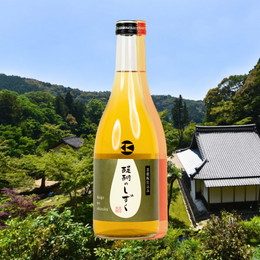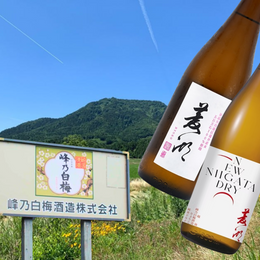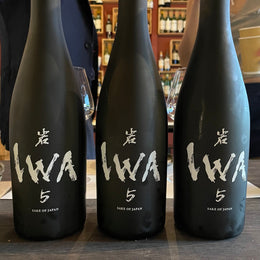
We've heard of sake brewers founded by sumo wrestlers, or those bestowed important titles by prominent samurai of the time. However, have you heard of a sake brewery founded by a pirate offshoot group? Neither did we - until recently! And even still, what's that got to do with sea breams and whirlpools?
![]()
A ship banner, with the three circles being the Matsuura family crest. Source: matsura.or.jp

Our story takes us a long way into Japanese history. Japan was going through it - warring clans, claims on territory and unrest was rifle. The Matsuura Party, pronounced Matsuura-to 松浦党 saw its beginning years in the 1000s - starting out as a bunch of military families that came from the Hizen province (modern day Nagasaki, at the northwestern tip of Kyushu Island).

Hizen Province, within modern-day Nagasaki. Source: Wikipedia
The group started their rise to power closer to the 1200s, when they operated more like sea pirates that pillaged towns and boats for food and villagers alike. Here, the Matsuura Party was known by a few names - such as the Matsuura Party, the Samurai of the Sea 海の武士団, or the Matsuura 48 Parties 松浦四十八党, as the group were divided into 48 sections with the central ruling Matsuura family at its core.

A Chinese depiction of "Wokou/Wako" pirates attacking naval fleets. Source: Wikipedia
The Matsuura Party was steeped in legend - notorious for attacking the Korean and Chinese ships that sailed in the oceans as well as pillaging coastal cities; or, famous for playing a role in the defence of Tsushima Island against the Mongols, establishing formal trade with Korea and China, and facilitating trade between Japan and the Portuguese and English in modern-day Nagasaki. The Matsuura Party had strongholds both within and beyond the Kyushu main island, but perhaps had the greatest presence within Hirado island.
![]()
While the bigwigs of the Matsuura Party were eventually assimilated into the shogunate and eventually the government during the Meiji Restoration, an offshoot group had split off from the Kyushu Island.
![]()
Honke Matsuura Shuzo. Source: wowma JP
2nd generation Naozo Matsuura 松浦直蔵由 founded the Honke Matsuura Shuzo 本家松浦酒造 in 1804 (which, considering the origins of the Matsuura Party in the 1000s, is a long way!), within Naruto town in the Tokushima Prefecture. The town is located right at the northeastern tip of the island, facing the Seto Inland Sea (of which, the Honke Matsuura Shuzo is 8 kilometres away from the shore). The Naruto Strait, specifically, is renowned for the many whirlpools that form and swirl in it.
![]()
Naruto Strait Whirlpool. This natural phenomenon also inspired a famous ukiyo-e painting by Utagawa Hiroshige. Source: Japan gate
And if you're wondering; yes, it is these whirlpools that inspired the white-pink swirlie surimi (fishcake) as a ramen topping, which in turn, inspired the name for Naruto Uzumaki, our favourite anime ninja (even the starting premise of the anime has references to the Naruto Bridge spanning the Naruto Strait).

I've never imagined an evening when I'll be writing about pirates, sake, whirlpools and anime all within the same article.
For such an iconic location, the sake brewery had to name one of their sake brands after the phenomenon. Hence, the name "Narutotai 鳴門鯛" - "naruto 鳴門" referring to the whirlpools, and "tai 鯛" refer to the sea bream that swims in the violent currents of the whirlpools and a local delicacy (apparently, the flesh of the sea bream is said to be one of the best, known to be meatier and tastier). Now you see how all the puzzle pieces fit together!
![]()
Narutotai Logo. Source: theartofsake.com
The 5th generation head of the brewery received the trademark for their flagship sake brand from the Tokushima Prefectural Governor in 1886. Apart from being the oldest brewery in Tokushima Prefecture, Honke Matsuura Shuzo was one of the first breweries to introduce a motor-powered rice polishing machine into its operations, and to this day, is said to be the only Tokushima sake brewery that has its own rice polishing machine.
![]()
The brewery's Toji is 10th generation Masaharu Matsuura 松浦正治. Source: wowma JP
The toji's aspiration is to balance and harmonise hand-made techniques and machinery techniques to get the tastiest sake possible.
We've had the opportunity to taste some sakes from the brewery - let's head straight to it!
-
Narutotai Ginjo Shiboritate Nama Genshu | 鳴門鯛 吟醸しぼりたて生原酒, 18.5% ABV – Review
Starting out this tasting is the most iconic product of the Narutotai sakes - the simplistic calligraphy written across an stubby aluminium can. Oddly enough, I found the packaging adorable.

The aluminium isn't exactly just for show or as a statement piece either - compared to glass, aluminium is lighter, cheaper, blocks UV rays, comes in a smaller package, and is easier to recycle. Honke Matsuura Shuzo was one of the earlier adopters of the canned sake, swapping to the vessel in 2016.

10th generation owner Motoko Matsuura sharing about using aluminium cans in an interview. Source: SAKETIMES EN
According to Honke Matsuura, the Nama Genshu is a particular hit in California and New York, earning the nickname "Namacan". It makes great sense to export, given how sake brewers have no assurance that the sake would be properly kept away from sunlight and damage as it jostles its way out of the brewery.

I too want the badge of honour to be repping a sake like that. Source: Tokushima Shop
For this sake, it is freshly made within the brewing year (shiboritate しぼりたて),unpasteurised (nama 生) and undiluted (genshu 原酒). The rice polishing ratio is 58% for this one, coming in at 18.5% ABV.

Apparently, the Namacan is also popular in Los Angeles a few decades from now, as seen in this cameo shot in Blade Runner 2049.
Nose: Smells deceptively like a shochu, with the roasty, savoury and “cooked” aromas I expect from a sweet potato shochu. There is a deep cereal fragrance of rice, with a background aroma of seafood-like sweetness that conjures images of asari clam broth.
Taste: Unexpectedly sweet, at least from the nosing. The sweetness of the sake tastes like a cross between dried banana chips and soy sauce. As I taste it a few more times, there is quite a kombu dashi-like umami sweetness as well.

Finish: The sweet savouriness is the mainstay flavour in the finish, reminding me of a bonito broth that has a spoonful of miso paste and a sprinkle of sugar mixed into it.
My Thoughts:
I love how unashamedly bold it is with its umami flavours, and I would imagine it tasting exactly like broth if heated up. This is the sake that I would recommend to go with seafood, as the natural savoury sweet profile would complement well with the oceanic sweetness of crustaceans (as we've had at World Sake Day 2023).
Narutotai Junmai Daiginjo 鳴門鯛 純米大吟醸, 16% ABV – Review

Now, you can't have a local delicacy rep your sake brand, and not make a sake to go with it, right? That's exactly where the Junmai Daiginjo comes into the picture - from the official website, it's built to be fruitier on the palate, made to pair with sea bream (especially grilled) and other white fish sashimi.
This sake is made with 100% Awaichiba Yamadanishiki あわいちば山田錦 rice - the coveted Yamadanishiki rice that is grown in Ichiba Town, Tokushima Prefecture. The rice polishing ratio is 40% for this one.
![]()
Nose: Smells like freshly prepared konbu stock. The umami character is more nuanced than the nama genshu - instead of a more shellfish-boiled stock aroma, you get a more steamed prawn meat sort of subtle savoury aroma instead.
Taste: Quite confectionery sweet. There is a syrupy sweetness to the sake - think longan juice and pasteruised pineapple juice minus the acid.

Finish: The finish becomes more green-banana like.
My Thoughts:
The sake here is a lot more delicate and refined here, with lots of nuance. While you get the big, bold, all-guns blazing sort of umami flavours in the former, here it is a lot more tempered, also having a sort of restraint. I think the sake here feels a lot sweeter, with much more subtlety and even fruitiness to be expected. I could see why this sake was championed to go with sashimi - just like those special sweet soy sauce, the sweetness and fruitiness of the sake really brings out the more sublime freshness in raw fish.
Narutotai Junmai Ginjo Ron Unpasteurised Light Nigori Sake | 鳴門鯛 純米吟醸 うすにごり生酒 凛, 15% ABV - Review
If there's anything that's brewing in Honke Matsuura, it's rare, hard-to-get again releases of sake that breaks away from the main lineup. This sake is given the name "Rin" for its dignified grace, while still retaining a strong core.

Apart from the official webpage, there really isn't much traces of this sake on the Interwebs. Here, the sake brewery team has released an usu-nigori うすにごり (quite literally translating to light nigori), a form of sake where the sake lees is mixed into the sake, this time on the lighter side. As this sake is unpasteurised, the active yeast has done just a bit more fermentation within the bottle, giving the sake a light fizz.
![]()
Sake lees. Source: Narutotai-JP
A drinking suggestion by the Honke Matsuura team was to first let the sake lees settle within the bottle, taste the clear sake that is floating at the top of the bottle, then shake up the bottle to taste the full expression of the usu-nigori.
![]()
As far as food pairings go from Honke Matsuura official website, this sake was paired with a lobster and sea bream lemon mousse, and is recommended to pair with strawberry, Camembert cheese, desserts, and intensely flavoured dried fruits like figs and raisins. If you need any re-assurance on the former pairings, a customer went to test the pairings with pan-fried sea bream and 7-Eleven lobster bisque, and was happy to report they indeed went well together!
![]()
We've got no lobster bisques, soft cheese or sea bream (unfortunately), but here goes our tasting:

Aroma: Big sweet scents of rice pudding, outlined by a light synthetic hit of magic marker. Despite its sweetness, it’s balanced out by some firm dryness as well giving it a good structure. There’s also some grapefruit acidity and a light bit of yogurt that cuts through the sweetness. Some notes of soursop as well.
Taste: Palpably the soft little rice clouds can be felt in the hazy cloudiness. It opens up with a bright fruitiness of sweet pomelos and white grape juice. In the background is a growing dryness.

Finish: The dryness continues to intensify. Finishing off with earthy brown rice and a light barnyard funk along with a couple of mangosteens tossed in.
My Thoughts
A really friendly and approachable Sake that has a good transition from sweet to dry that makes it very entertaining and memorable. The flavours here are big and forward, without having to think too hard. There’s a simplicity and straightforwardness here that will definitely find wide appeal.
Conclusion
I think Honke Matsuura's sakes really places a lot of emphasis on it's oceanic DNA and food pairings - you definitely can taste quite a bit of that seafood savouriness in their main line-up. I definitely suggest picking up one of the Narutotai sakes when you come across them, and definitely pair them with food! I be reaching for a few Namacans myself if I get the opportunity.

@vernoncelli







